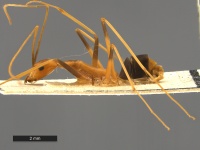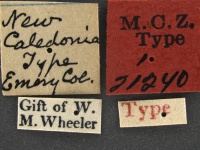Leptomyrmex geniculatus
| Leptomyrmex geniculatus | |
|---|---|

| |
| Scientific classification | |
| Kingdom: | Animalia |
| Phylum: | Arthropoda |
| Class: | Insecta |
| Order: | Hymenoptera |
| Family: | Formicidae |
| Subfamily: | Dolichoderinae |
| Tribe: | Leptomyrmecini |
| Genus: | Leptomyrmex |
| Species: | L. geniculatus |
| Binomial name | |
| Leptomyrmex geniculatus Emery, 1914 | |
Collected in rainforest and dry forest but its nesting habits are unknown.
| At a Glance | • Replete Workers |
Identification
The distinctive color pattern that distinguishes Leptomyrmex geniculatus from its two New Caledonian congeners is the combination of dark gaster and dark distal portions of the femora on an otherwise orange body. In some specimens the pronotum may also be dark. Aside from these color differences, this species greatly resembles Leptomyrmex pallens and Leptomyrmex nigriceps. There are scattered records of this species throughout the island, where it has been found in sympatry with L. pallens. This species appears to be less commonly encountered than L. pallens. (Lucky and Ward 2010)
Key to New Caledonian Leptomyrmex Species
Keys including this Species
Distribution
Latitudinal Distribution Pattern
Latitudinal Range: -20.45000076° to -20.53333282°.
| North Temperate |
North Subtropical |
Tropical | South Subtropical |
South Temperate |
- Source: AntMaps
Distribution based on Regional Taxon Lists
Australasian Region: New Caledonia (type locality).
Distribution based on AntMaps
Distribution based on AntWeb specimens
Check data from AntWeb
Countries Occupied
| Number of countries occupied by this species based on AntWiki Regional Taxon Lists. In general, fewer countries occupied indicates a narrower range, while more countries indicates a more widespread species. |

|
Estimated Abundance
| Relative abundance based on number of AntMaps records per species (this species within the purple bar). Fewer records (to the left) indicates a less abundant/encountered species while more records (to the right) indicates more abundant/encountered species. |

|
Biology
Castes
Queen and male unknown.
Phylogeny
| Leptomyrmex |
| ||||||||||||||||||||||||||||||||||||||||||||||||||||||||||||||||||||||||||||||||||||||||||||||||||||||||||||||||||||||||||||||||||||||||||
Based on Barden et al., 2017. Note only selected Leptomyrmex species are included.
Nomenclature
The following information is derived from Barry Bolton's Online Catalogue of the Ants of the World.
- geniculatus. Leptomyrmex pallens var. geniculata Emery, 1914f: 418 (w.) NEW CALEDONIA. Subspecies of pallens: Wheeler, W.M. 1934c: 109. Raised to species: Lucky & Ward, 2010: 36.
Unless otherwise noted the text for the remainder of this section is reported from the publication that includes the original description.
Description
Worker
Lucky and Ward (2010) – measurements (n = 7) HL 1.80–1.95, HW 0.99–1.10, MFC 0.22–0.26, IOD 0.55–0.61, SL 3.36–3.81, EL 0.33–0.38, WL 3.21–3.52, PW 0.86–0.94, DPW 0.40–0.43, HTL 3.80–4.17, HTWmin 0.10–0.15, HTWmax 0.17–0.19, CI 0.54–0.57, SI 3.39–3.63, OI 0.09–0.11, HTC 0.61–0.85.
L. geniculatus is a small species (HW 0.99–1.10 mm; WL 3.21–3.52 mm) with elongate head nearly twice as long as broad, excluding mandibles (CI 0.54–0.57). Sides of head parallel, slightly convex, posterior to eyes head narrowing gently to flat postocular margin. Approximately 15 teeth and denticles interspersed on masticatory margin of mandible. Anterior clypeal margin flat to weakly concave. Eyes positioned approximately at midline of head, relatively large, convex, hairless, not reaching the lateral margins of head. Antennae extremely slender, but not compressed. Scapes extending past the posterior margin by 2/3 their length.
Pronotum elongate. Propodeum short, dorsal face about 1.5 times as long as the convex declivitous face, angle rounded. Dorsal face of propodeum convex, with a transverse impression at the anterior end. Petiolar node small, triangular in profile with a rounded dorsum. Anterior, dorsal and posterior face of petiole with longitudinal impression posterior face longer than anterior, ventral surface flat. Gaster broadly elliptical. Legs very slender, not compressed (HTC 0.61–0.85).
Surface finely and densely shagreened, slightly shining. Mandibles with a single row of coarse punctures along margin. Pubescence white, extremely fine standing hairs scarce, confined to clypeus, venter and gaster. Body mostly pale rufotestaceous, with first two segments of gaster and distal 1/2 to 1/3 of femora black. Head and sometimes pronotum slightly darker than body.
Type Material
Lucky and Ward (2010) – Syntypes, 2 workers, New Caledonia: Coula-Boréaré (Sarasin & Roux) Museo Civico di Storia Naturale, Genoa; syntypes, 2 workers, New Caledonia: Tchalabel (Sarasin & Roux) MSNG; also 1 syntype worker, New Caledonia: "New Caledonia" Museum of Comparative Zoology. One worker from Coula-Boréaré here designated lectotype (CASENT0127391).
References
- Emery, C. 1914f. Les fourmis de la Nouvelle-Calédonie et des îles Loyalty. Nova Caled. A Zool. 1: 393-437
- Lucky, A. 2011. Molecular phylogeny and biogeography of the spider ants, genus Leptomyrmex Mayr (Hymenoptera: Formicidae). Molecular Phylogenetics and Evolution 59: 281-292. doi:10.1016/j.ympev.2011.03.004
- Lucky, A.; Ward, P. S. 2010. Taxonomic revision of the ant genus Leptomyrmex Mayr (Hymenoptera: Formicidae). Zootaxa 2688:1-67.
References based on Global Ant Biodiversity Informatics
- Baroni Urbani C. 1977. Katalog der Typen von Formicidae (Hymenoptera) der Sammlung des Naturhistorischen Museums Basel (2. Teil). Mitt. Entomol. Ges. Basel (n.s.) 27: 61-102.
- CSIRO Collection
- Emery, C. 1914. Les fourmis de la Nouvelle-Calédonie et des îles Loyalty. Nova Caledonia. A. Zoologie 1:393-437.
- Jennings J. T., L. Krogmann, and C. Burwell. 2013. Review of the hymenopteran fauna of New Caledonia with a checklist of species. Zootaxa 3736(1): 1-53.
- Lucky A., and P. S. Ward. 2010. Taxonomic revision of the ant genus Leptomyrmex Mayr (Hymenoptera: Formicidae). Zootaxa 2688: 1-67.
- Shattuck S. O. 1994. Taxonomic catalog of the ant subfamilies Aneuretinae and Dolichoderinae (Hymenoptera: Formicidae). University of California Publications in Entomology 112: i-xix, 1-241.
- Taylor R. W. 1987. A checklist of the ants of Australia, New Caledonia and New Zealand (Hymenoptera: Formicidae). CSIRO (Commonwealth Scientific and Industrial Research Organization) Division of Entomology Report 41: 1-92.
- Wheeler W. M. 1915. The Australian honey-ants of the genus Leptomyrmex Mayr. Proceedings of the American Academy of Arts and Sciences 51: 255-286.
- Wheeler W. M. 1934. A second revision of the ants of the genus Leptomyrmex Mayr. Bulletin of the Museum of Comparative Zoology 77: 69-118.
- Wheeler W.M. 1935. Check list of the ants of Oceania. Occasional Papers of the Bernice Pauahi Bishop Museum 11(11):1-56.
- Wheeler, W. M. 1927. The ants of Lord Howe Island and Norfolk Island. Proc. Am. Acad. Arts Sci. 62: 121-153


